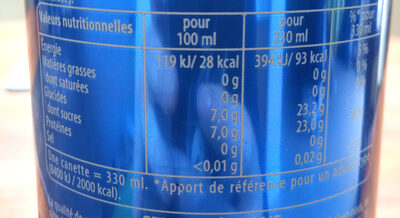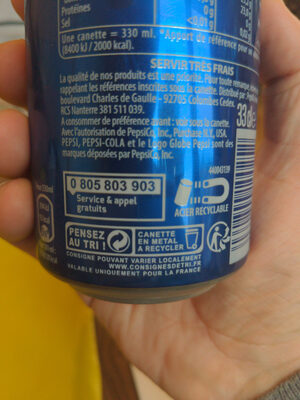pepsi - 330 ml
This product page is not complete. You can help to complete it by editing it and adding more data from the photos we have, or by taking more photos using the app for Android or iPhone/iPad. Thank you!
×
Some of the data for this product has been provided directly by the manufacturer PEPSICO FRANCE.
Barcode: 4060800100252 (EAN / EAN-13)
Common name: Boisson gazeuse rafraîchissante aux extraits végétaux avec sucre et édulcorant.
Quantity: 330 ml
Packaging: Boîte de conserve ou canette, Canette, Aluminium-can
Brands: Pepsi
Categories: Beverages, Carbonated drinks, Artificially sweetened beverages, Sodas, Colas, Sweetened beverages, Boissons, Boissons avec sucre ajouté, Boissons gazeuses, Boissons sans alcool, Boissons édulcorées, Sodas au cola
Labels, certifications, awards: Point Vert
Countries where sold: Belgium, France, Switzerland
Matching with your preferences
Other information
Preparation: Servir très frais
Conservation conditions: A consommer de préférence avant : voir sous la canette.
Customer service: PepsiCo France SNC, 15 boulevard Charles de Gaulle 92705 Colombes Cedex
Report a problem
Data sources
The manufacturer PEPSICO FRANCE uses Equadis to automatically transmit data and photos for its products.
Product added on by malikele
Last edit of product page on by off-replace-bot.
Product page also edited by ecoscore-impact-estimator, fiffi, foodrepo, guezguez-majed, halal-app-chakib, hungergames, ihavenoidea, inf, kiliweb, openfoodfacts-contributors, openshark, org-pepsico-france, packbot, reckerl, roboto-app, scanbot, stephane, swipe-studio, tacite, terrysan, yuka.SFA4aU81Z2gvZE1qbmZSZzdoekw1bzFYbmNHVGYyRHZGK01nSVE9PQ, yuka.U0pwZEs0c0ZtZHczdHZFT29Rekt4K3hieG9DTVpGaVFFdWdxSVE9PQ, yuka.UWZzT0ZvVmF2OHNYbHNRSC8wcmFxb05UNGFXQVJqaTNFTkJMSVE9PQ, yuka.UmY0SEZ2d2hvdmNEcWRvRTlBL2w1K3QyMnE2WWJVaW5CYmM2SUE9PQ, yuka.V2JFZkdhQWJudEpVaTh4Zy9CelE0TkZJMzYremNFS3FNTG9xSVE9PQ, yuka.VDVJdFQvb0VvcWNEdTlnQzREenRwY0pLMXJMMVR6eXdOY2NqSVE9PQ, yuka.VjRZaFRyZ3N2ZmdCbU04Yzhqbk15LzBsbXNXVlFEMk5MOXNRSWc9PQ, yuka.VjZBdlA3b2FwNmdwZ1Awc29nanJ5UEZWeVlLMFRXYm9kY2NESWc9PQ, yuka.WEtsUkRQZzVpL3BVZzhNWTlVems4L1JjbHJhUFoxMk5jdGMySVE9PQ, yuka.WUo0QlNmc3h2K1FFaE1NdThCTFM5OGhQM0xHSVpEcVhlcm9mSVE9PQ, yuka.YTZ0Yk40QXRwYUVtcHZjVC9BSGUrTjFZMWJMNGN6NkxEY2dMSVE9PQ, yuka.YVpnK0hJb0VuZFVZeGNVRjlEemJ5dk5vK3IyTWZXbVhBZTgrSVE9PQ, yuka.YWEwWUVZQU1vZHMyeC9JbndDUDNwdjlsMkpxbFhFK29lOU1oSVE9PQ, yukafix.












